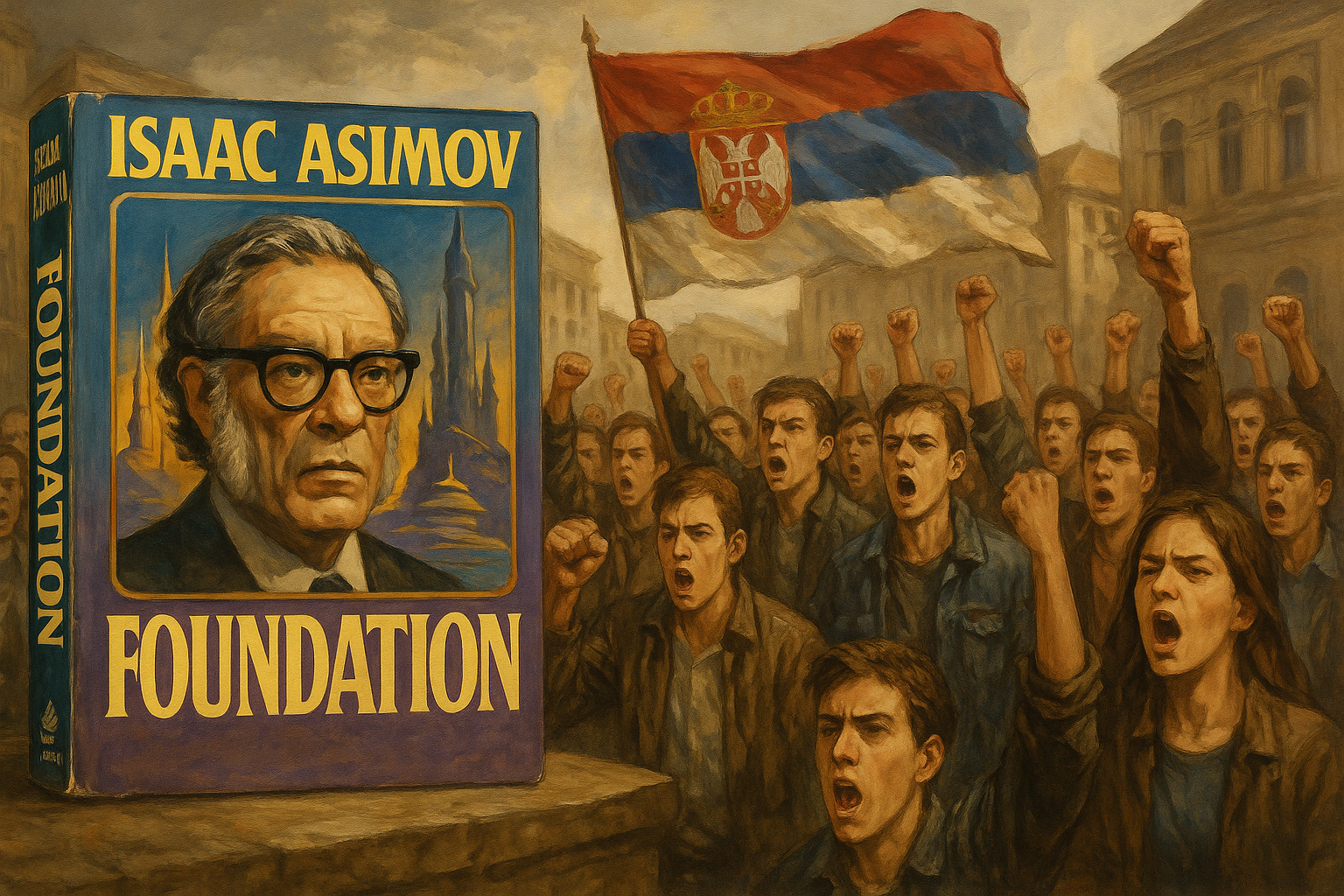Serbia’s Uprising: A Foundation for Democratic Revival
In Isaac Asimov’s Foundation series, Hari Seldon pioneers psychohistory to predict the Galactic Empire’s collapse and charts a path to renewal through determined collective action. Today, Serbia’s students embody this vision, rising against autocracy and corruption in the wake of a tragic railway collapse in Novi Sad on November 1, 2024, that claimed 16 lives, including children. Sociologist Jovo Bakić, a modern echo of Seldon, foresaw this uprising in a 2019 interview, declaring, “I would like us to chase [corrupt leaders] through the streets. That is revolution.” Now, as students march from Serbia’s villages to Strasbourg’s EU halls, their movement is not only transforming their nation but igniting a spark for democratic revival across Europe and beyond.
A Serbian Awakening Born of Tragedy
The Novi Sad disaster, tied to a Chinese-led railway project marred by ignored safety warnings and cronyism, exposed the rot of Serbia’s autocratic system under President Aleksandar Vučić. Students, embodying a societal conscience akin to Seldon’s Foundation, responded with silent tributes that swiftly evolved into a nationwide call for accountability. Joined by farmers, teachers, lawyers, and cultural figures, they’ve mobilized hundreds of thousands across 400 cities and towns by March 2025, with daily “Serbia, stop” traffic blockades and faculty occupations. Public support is strong—61% of Serbians back the protests, and 52% distrust Vučić, per recent polls.
Yet, this awakening faces fierce resistance. Vučić’s regime, controlling nearly 90% of media, deploys police violence, smear campaigns, and punitive measures like slashing striking professors’ salaries (one received just 23 dinars for February). Ideological fractures, including anti-Western and pro-Russian sentiments among some protesters, further complicate the movement’s unity. Despite these challenges, the students’ resolve mirrors Seldon’s adherents, who persisted against galactic odds to preserve hope.
From Villages to Strasbourg: A Blueprint for Change
Like Seldon’s Foundation starting on the Empire’s distant Terminus, Serbia’s students began their movement in overlooked rural communities. Marching through towns and villages, they sowed solidarity among those long silenced by state propaganda. This grassroots approach, conquering smaller towns before urban centers, created a groundswell of support—200,000 rallied in Belgrade on March 15, 2025. As student leader Ana Petrović declared, “We’re not just fighting for Novi Sad’s victims; we’re fighting for a Serbia where no one dies from corruption.”
In a bold act, students cycled 1,300 kilometers to Strasbourg, arriving April 15, 2025, to appeal to EU institutions. Their “Tour de Strasbourg” drew global attention, with Serbian diaspora protests in Vienna and Bratislava amplifying their call. Though the EU’s response has been cautious—prioritizing stability over robust support—the students’ journey symbolizes a universal demand for transparency and justice, offering a blueprint for challenging autocracy worldwide.
A Spark for Europe and Beyond
Could Serbia’s uprising be a foundation for Europe’s democratic awakening? The continent faces authoritarian drift, from Hungary’s Viktor Orbán to France’s far-right surge. Serbia’s students join a wave of youth-led resistance, echoing Georgia’s 2024 anti-“foreign agents” protests and Hungary’s 2017 CEU demonstrations. Eurobarometer data shows declining trust in governments across Europe, suggesting Serbia’s fight taps into a broader hunger for change. Yet, the EU’s ambivalence and Serbia’s declining support for integration (below 50%) highlight hurdles to continental impact.
Globally, Serbia’s movement resonates with struggles like Chile’s 2019 anti-inequality protests and Sudan’s 2019 revolution, where youth challenged systemic failure. The universal themes—corruption, democratic erosion, disenfranchisement—transcend borders. As Seldon’s Foundation preserved knowledge for a new era, Serbia’s students are safeguarding democratic ideals, proving that collective action can ignite hope anywhere.
Lessons from History, Hope for the Future
Serbia’s uprising is not guaranteed to succeed. Historical movements, like North Macedonia’s Color Revolution, show that protests often yield partial change without uprooting systemic corruption. Vučić’s partial concessions, like the resignations of key ministers, mask his grip on power. Without sustained pressure, an “interregnum” could usher in another autocrat.
Yet, the students’ courage offers a powerful lesson: change begins with those bold enough to demand it. To build on Strasbourg, they could unite diverse factions into a clear platform, partner with global anti-corruption networks, or leverage diaspora support. Their fight challenges us all—whether in Belgrade, Brussels, or beyond—to confront corruption and autocracy in our own systems.
Just as Seldon’s vision required determined individuals to realize psychohistorical predictions, Serbia’s youth are transforming tragedy into a foundation for renewal. They remind us that democracy is not a gift but a struggle, and their spark could yet light a global flame. Join their call: demand justice, reject corruption, and build a future where power serves the people.
In Asimov’s world, the Foundation’s strength lay in knowledge and unity. Serbia’s students are proving the same can be true for democracy.

